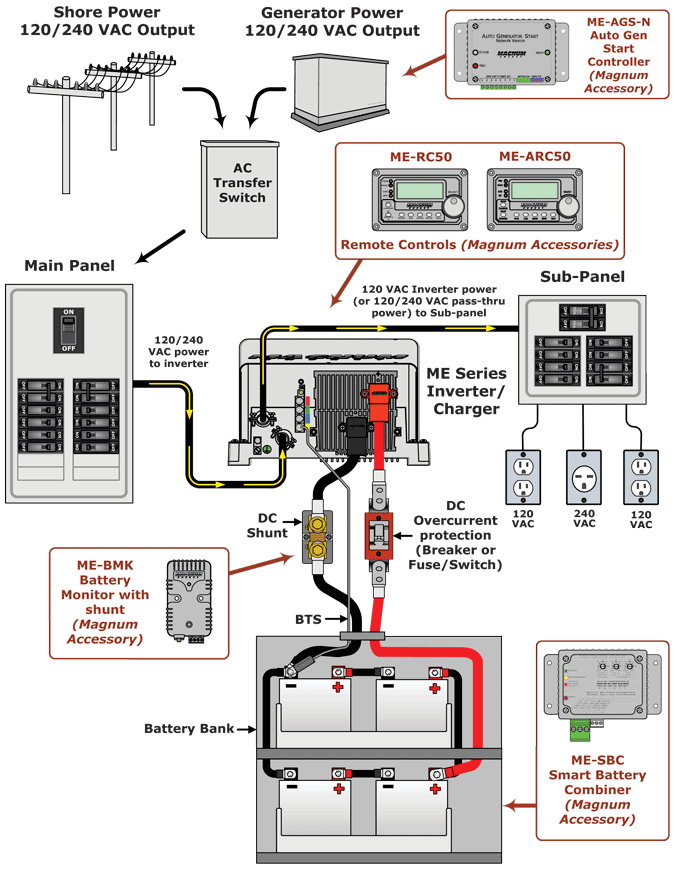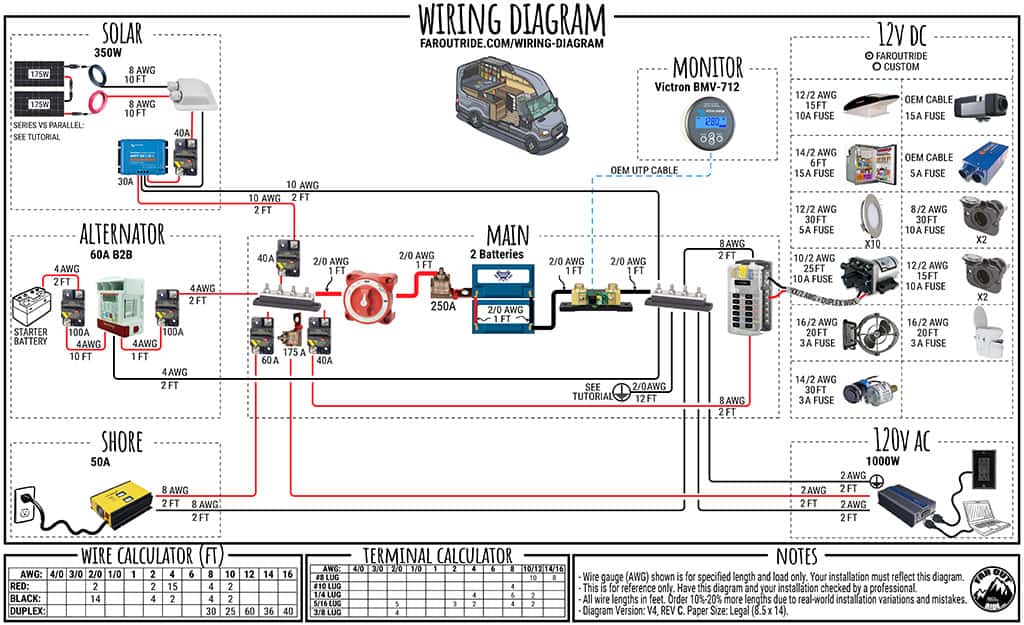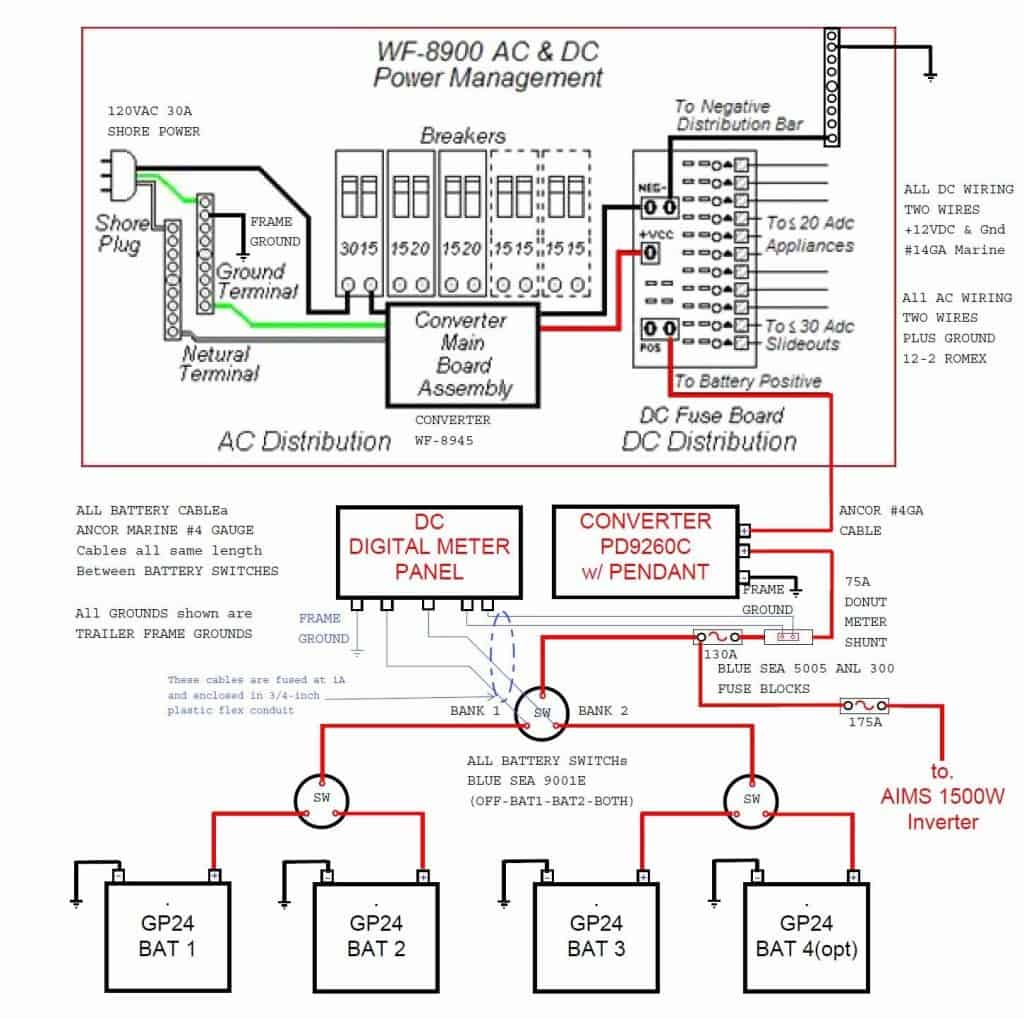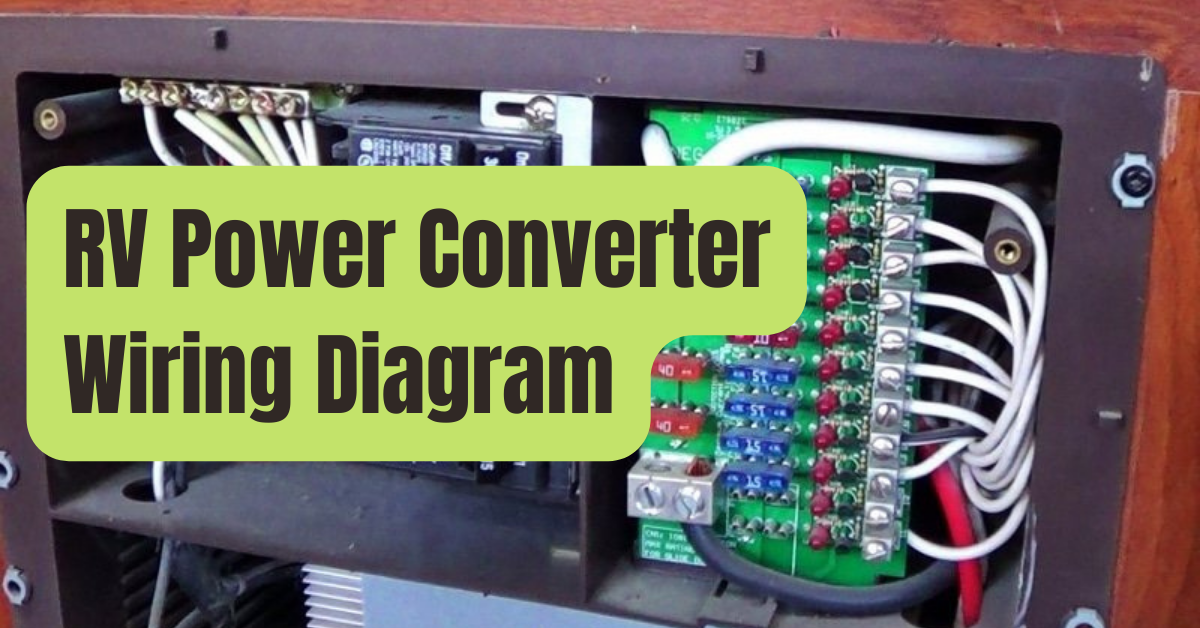In this post, we’ll show you how to install an RV inverter, offer you a wiring schematic for one, and advise you on which model is ideal for your requirements.
Diagram Of An RV Inverter
The most common wiring schematic for an RV inverter may be seen here.
But before you start, we urge you to consider the following crucial advice for installing an RV inverter:
- Always place a fuse in the event of a short circuit between the battery and the power inverter so that the installation is safeguarded.
- If the inverter will be operated continually, install it with the least amount of ventilation possible (for example, if it supplies a 220V refrigerator)
- As long as you DO NOT add an extension chord or expand the 220V installation, an inverter DOES NOT need further permission. They don’t see it on ITV, at least.
- Consult our guide on electrical installation if you have any more queries, or post a comment.
#1. Diagram for an RV Inverter 1

#2. Diagram for an RV Inverter 2

#3. Diagram for an RV Inverter 3

An RV Inverter Is What?
The inverter is a device that will be directly connected to our secondary battery (you can refer to our electrical diagrams) and will essentially allow us to convert the electricity provided by our 12V battery to 220V so that we can connect our most commonly used appliances, like the laptop, through a regular plug, like those at home.
The inverter uses waves to change the electricity from 12 volts to 220 volts.
There are many various kinds of converters on the market, but generally speaking, we can divide them into two groups:
RV Pure Sine Wave Inverter
- It produces a wave comparable to the size of the dwellings;
- It may be applied to motorized machines;
- But the price is substantially higher.
RV-Compatible Rectified Wave Inverters
- Creates a square wave that aims to resemble a pure sine wave;
- Only basic motorless gadgets (TVs, computers, etc.) are utilized with it;
- It costs less;
- The main drawback is that it doesn’t operate with products like hairdryers that have motors or heat resistance.
How To Choose An Inverter For An RV
We must be aware that this sort of gadget has nominal power and peak power before choosing our inverter.
- The electricity that the inverter can provide to you nominally during routine, continuous usage.
- Peak power is the maximum amount of power it is capable of giving you.
It is crucial to consider both values, and certain starting points call for that peak power.
Fuse and even the inverter might explode if an item needs more power than the converter can provide.
This implies that if I want an inverter to connect to a computer, the computer will undoubtedly need 240 watts of power on average but 500 watts at startup, thus the inverter has to be able to provide us with these powers.
All of the components linked to batteries will utilize the energy they contain, as we have previously discussed.
We must consider how we will connect and if our batteries will be able to provide us with the power that the inverter transforms before connecting.
Otherwise, we run the risk of exhausting the battery in our backup battery after just two uses of any of the inverter-connected devices; not because the inverter isn’t working, but rather because the electricity stored in our backup battery is insufficient to meet the demands of the devices we want to use.
We keep in mind that while selecting an inverter, we must make sure that it is not constantly operating at maximum efficiency since doing so might result in burnout and other issues.
It is advised that our investor operate at a 70 percent efficiency level.
In other words, the ideal thing to do is to get a 400W inverter if we want to connect a computer whose charger indicates that it operates at 240W.
We will have adequate room if we use one of 300W instead.
Bapdas 300W Power Inverter, DC 12V, 220V-240V AC Output, Dual USB Ports 5V/2.1A
- It contains two flexible ports (5V/2.1A each) for charging cellphones, tablets, and other USB-powered devices.
- Built-in cooling fan that protects the work from overheating and maintains its quality
- Intelligent protection against overload, overheating, short circuit, and overvoltage
- It may be plugged into a 12V outlet.
- Instantaneously, an inverter transforms 300 watts of continuous DC to AC.
- Integrated cooling fan,
- Clever defense against short-circuit and overheating
- Economic
- Excellent durability outcomes.
- 1000W for continuous power and 2000W for maximum power.
- LED displaying any inverter abnormality.
- Power manager and intelligent fan that activates when it becomes too hot.
- Protection against overload, short circuit, low voltage input, high voltage input, and temperature.
EDECOA Pure Wave Inverter 12v 220v converter 1000w of Pure Wave 12v 220v with Remote Control
Any gadget having a motor or thermal resistance might be connected.
- A remote control should be brought along
- Automatic voltage control is included.
- Positive outcomes
- More expensive than modified wave
- Any gadget having a motor or thermal resistance might be connected.
- Automatic voltage control is included.
- Positive outcomes
- Less cost-effective than modified wave versions, but still offers excellent value.
What Kind Of Inverter Power Do I Require?
If you’ve previously looked at inverters, you know that they each provide a unique power source (Expressed in Watts, W).
Well, the power they demonstrate is what it is capable of providing at a certain time.
In other words, many electrical items that together use less power than 500W may be connected to a 500W inverter.
How much energy does each gadget use?
The majority of items mention consumption, however you may also use the following table as a general reference.
| Product | Consumption (WATT) |
| Digital camera / mobile charger | 10 |
| Electric mixer | 400 |
| Small refrigerator | 160 |
| LED TV | 200 |
| Game console | 250 |
| Small electric fan | 350 |
| Electric drill | 500 |
| Refrigerator | 600 |
| Food processor | 900 |
| Small microwave | 750 |
| Air conditioning | 1300 |
| Toaster | 1400 |
| Vacuum | 1560 |
| Hairdryer | 1750 |
| Electric kettle | 2000 |
| Air Compressor | 3000 |
Last Advice
A 500-600W inverter will undoubtedly be more than plenty if you won’t be regularly using a microwave or a refrigerator.
On the other hand, we advise at least a 1000–1200W inverter if you want to utilize a device like the microwave.
The peak power of the inverters is also often twice as much as the nominal power.
This shows the power that they are able to provide in a relatively little period of time (seconds), such as when an engine is started, for example.
If you have any inquiries or remarks on the information, do let us know.
FAQs
How does an RV’s electrical system function?
Everyday outlets typically operate at 220 volts, but an RV can only produce 12 volts.
With a completely charged battery, this implies that you will most likely have two hours with the lights on and two hours with the television throughout the journey.
The battery will expire at the conclusion of this period.
How is a motorhome’s battery recharged? Does it need to be plugged into 220 volts?
Thanks to the energy produced by the motor, the batteries are automatically replenished.
Connecting the RV to 220V electricity is another option for charging the battery, albeit in this instance it just impacts the auxiliary.
For a motorhome, how many solar panels are required?
So, about two 150W solar panels would be plenty, but what about winter? Since there is less sunlight during the winter, we typically figure that each plate will provide around 250W, thus four plates of 150W are required.
How long does it take an RV battery to charge?
Therefore, the charging period for a 100Ah battery is 12 to 16 hours at the very least, and it is doubled if we have two batteries.
Installing a specific 20 A electrical charger is required if you wish to recharge more quickly.










